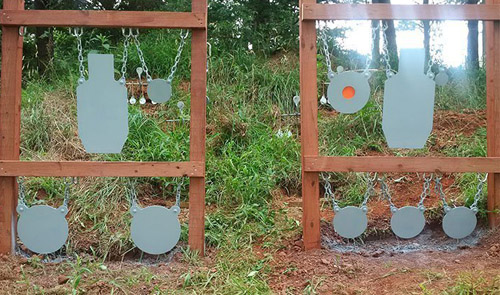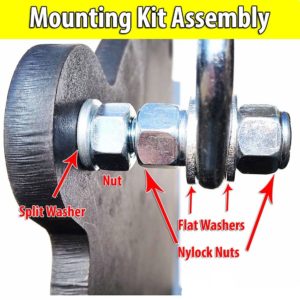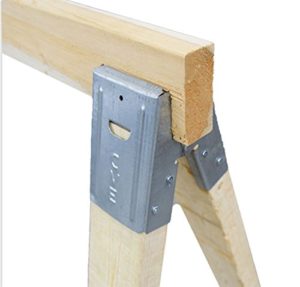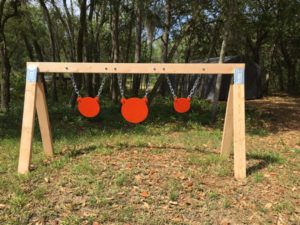What Type Of Steel Is Used For Steel Targets?
The short answer is AR500 steel. Some manufactures may use harder steel like AR550 on up to AR600 although. The “AR” stands for Abrasion Resistant while the number that follows (typically 500) is the Brinell hardness number or BHN.
In order for steel targets to be safe and work correctly you need a BHN of at least 500. This type of steel is through hardened and is extremely tough and durable. In fact, it is commonly used in body armor in a wide range of applications.
Using a softer steel as a target can be extremely dangerous since the surface will pit causing an unpredictable fragment pattern and ricochets. A hard flat surface is required and will create a predictable splatter pattern that can safely be used for target shooting.
Is Shooting Steel Targets Dangerous?
Shooting steel targets made of AR500 steel or harder is pretty safe as long as the target is mounted correctly (which I will discuss in the sections below) and shot from a safe distance. Since AR500 steel is so hard and tough, it can fragment bullets in a consistent and predictable manner, most often no more than 20 degrees.
Shooting softer, non-AR500, steel plates that you might find at a scrap yard or even at a hardware store can be very dangerous since the softer steel will easily pit and potentially ricochet fragments back at the shooter.
So if you are thinking about making steel targets from scrap metal, think twice and instead look up some inexpensive options from reputable manufactures. It should go without saying that you should always shoot with proper eye and ear protection (see recommended amplified ear muffs for steel target shooting).
If the targets is shot too closely from high velocity rounds, the surface will begin to pit. This in turn causes the bullet fragments to leave the target surface in an unpredictable manner which could potentially come back towards the shooter.
The target should also be mounted with carriage bolts or similar to make sure there are fewer turns or curves the fragments can follow back to the shooter, more on this in the mounting section.
Lastly if you are shooting steel targets near dry vegetation know that there is a spark hazard when using steel core or bi-metal jacketed ammunition. Any type of bullet that is magnetic is not recommended for steel targets.
Where to Buy Steel Targets?
There are a ton of great manufactures out there. I would look for reputable companies that have lots of positive feedback from customers.
If you are a big fan of Amazon I would check out a starter pack like this from AR500 Target Solutions. When you are first starting out you will want to have several targets to shoot at. The variety of shooting different size targets at different ranges with different noises is what makes it such a blast!
How Close Can I Shoot Steel Targets?
In general, using lead-core Full Metal Jacketed (FMJ) bullets, you want to be at least 10 yards for most non-magnum pistol calibers and 100 yards or more for high velocity rifle rounds like a .223/5.56. The reason for this is that AR500 steel will begin to pit when it is struck by bullets traveling faster than 2850 feet per second.
An AR-15 with a 16″ barrel firing a 55gr .223 round leaves the muzzle at approximately 2900-3000 feet per second. This means that you must shoot the target from a greater distance to give the bullet time to slow down. The pitting is caused from the tremendous amount of heat generated by the bullet impact and is a function of the projectiles velocity.
A 4″ thick AR500 steel plate will still pit from an AR-15 at 50 yards. The main rule for steel target shooting is to keep your rounds under 2850 feet per second. This will preserve the life of the target and keep them functioning safely and properly.
If you want to shoot steel targets closer than these recommended distances, frangible ammunition should be considered. Frangible bullets are made of compressed copper powder instead of a solid lead core which disintegrates immediately on impact with solid object like a steel target.
How Thick Do Steel Targets Need To Be?
Here are some quick reference tables to help select the proper target thickness with the pistol, rifle or shotgun caliber you intend to use.
Steel Target Thickness vs. Pistol Caliber
| Pistol Calibers | 3/16" AR500 | 1/4" AR500 | 3/8" AR500 | 1/2" AR500 |
|---|---|---|---|---|
| 22 LR | ||||
| .25 ACP | ||||
| .32 ACP | ||||
| .380 ACP | ||||
| 9mm | ||||
| .357 Magnum | ||||
| .40 S&W | ||||
| .44 Magnum | ||||
| .45 ACP | ||||
| .454 Casull | ||||
| .50 AE |
Steel Target Thickness vs. Rifle Caliber
| Rifle Caliber | 3/16" AR500 | 1/4" AR500 | 3/8" AR500 | 1/2" AR500 |
|---|---|---|---|---|
| .22 LR | ||||
| .17 MHR | ||||
| .22-250 | ||||
| .223 REM / 5.56 NATO | ||||
| 7.62 x 39 | ||||
| .243 | ||||
| .260 | ||||
| .308 REM | ||||
| 30-06 | ||||
| 7mm | ||||
| .300 WIN MAG | ||||
| .338 LAPUA MAG | ||||
| .50 BMG |
Can I Shoot Steel Targets With A Shotgun?
You sure can! Using bird shot is a great way to remove paint on your target, but you can also use slugs and buckshot as well. Here is the recommended thickness for your shotgun.
Steel Target Thickness vs. Shotgun Caliber
| Shotgun | 3/16" AR500 | 1/4" AR500 | 3/8" AR500 | 1/2" AR500 |
|---|---|---|---|---|
| .410 Slug or Buckshot | ||||
| 20g Slug or Buckshot | ||||
| 16g Slug or Buckshot | ||||
| 12g Slug or Buckshot |
What Ammunition Should I Be Using With Steel Targets?
Normal lead-core copper jacketed (FMJ) ammo is just fine for steel target shooting. You want to avoid using steel core ammo or steel-penetrater rounds like green tips. If it isn’t obvious, lead is softer than steel and “splatters” a lot easier. Any projectile that is magnetic should not be used with steel target since they tend to be harsher on your target and present spark risks.
You can use frangible ammunition that is made of compressed copper powder that allows you to shoot your targets at a much closer range since they crumble upon impact. They are safer to use but cost you more money, I stick with FMJ’s at the recommended distances above.
What Steel Targets Are The Loudest?
So this was one of the first questions I wanted the answer to. Over time I gathered information and tested things on my own to determine what makes the loudest steel target. The short answer is big and thin targets are loudest, but let me break things down a bit more for those interested.
- Quality of the target
Some manufactures of steel targets are not telling the truth about their steel and therefore produce a less than desirable result. You want true AR500 steel, not knock-off stuff that is softer and less safe. I like the products made by Shooting Targets 7.
- How thick the target is
In general, a thinner target will produce the loudest result. The caution here is that you must comply with the recommended thicknesses vs. caliber from the tables above or else you may damage your target or have safety issues.
- How large the target is
Bigger is better! Some of my larger Silhouette and Gong targets that are 1/4″ and 3/8″ thick are super loud with pistol and most rifle rounds. I recommend a 16″ Gong that is 3/8″ thick like this one for most applications or a large 3/8″ Silhouette like this one for some loud and satisfying feedback on your shooting! If you are only using small caliber pistols then try 1/4″ thickness in these sizes for an even louder ring.
- How the target is mounted
Having the steel target rigidly attached to your mount will dampen the vibrations and make it quieter. You want to attached the target so it can move freely and resonate in the air.
A common method of attachment is to hang the target by chains (for most Gong style targets) or use Shepherd hooks for smaller targets that you can simply stick in the ground (see my section below for more mounting details). However you do it, try to make sure the target can move freely. This helps with the sound and also prevents damage to your target.
- The round you are shooting
If it isn’t obvious, shooting a target with a bigger faster bullet makes a louder noise than a small slow one! Don’t expect to hear a loud ring with a .22 LR bullet hitting a 2″ gong that is 1/2″ thick AR500 steel.
- Use the right ear protection
This has nothing to do with the target itself but rather making the most of the situation. My recommendation is to use a good quality set of amplified ear muffs to hear the ringing sound, otherwise your normal ear protection will rob you of that satisfying sound.
If you don’t know what these are, they are ear muffs that amplify all sound under a certain decibel reading while everything above (like a gunshot) gets cutoff. What this does is protect your ears from the gunshot but allow you to clearly hear the ring from the target.
These are great for all shooting applications since they allow you to easily hear people speaking while protecting your ears from gunfire. There are a ton on these on market however a lot of people including myself use Howard Leight’s because they are inexpensive but work really well. Check them out on Amazon.
How Do I Mount Steel Targets?
For most small gong type targets up to 8″ in diameter and 3/8″ thick, I prefer to mount them using a simple Shepherds hook. This is one of the easiest and efficient ways to mount a target. The Shepherds hook is light and easy to transport, which is a huge plus if you have to travel to shoot your steel targets.
They also allow the target to swing and release energy from the bullet impact. The only downsides to shepherd hooks is that the ground needs to be soft enough to stick in the ground and secondly they will not support bigger heavier targets.
As the targets get larger many people like to hang the targets off a horizontal beam like a wooden 2×4 with a set of short chains or rubber straps. This is achieved by bolting the chain or straps to the back side of the target with carriage bolts.
Carriage bolts are used since the head of the bolt that faces the shooting side is low profile and is unlikely to redirect fragments back towards the shooter.
A hex bolt head will create a 90 degree transition from the target face that can ricochet fragments back at the shooter which isn’t ideal. You also want to select a bolt that will be long enough to go through your target and have enough threads left to attach some extra washers and nuts like the figure below.
This offset from where the chain attaches is important because it will cause the target to angle downward which safely deflects the bullet fragments into the ground. You can buy all associated parts at a hardware store or order an inexpensive a kit like the one below (click).
With one end of the chains attached to the back of the target, the other ends are attached to a horizontal 2×4 so that the target can hang freely. Making a stand is not too difficult, the challenge can be making something light weight and easy to manage.
One simple trick is to use inexpensive sawhorse brackets like the ones shown below to support the horizontal 2×4. All you have to do is cut 2×4’s to the lengths you want and attach them to the brackets. After that, bolt on your targets and you now have an inexpensive yet sturdy steel target stand.
For those of you who just want to start shooting but don’t want to spend time making a stand, there are many options on amazon that require less work. I like the stand below since it is easy to use and doesn’t take up a lot of storage space when not in use, check it out.
There are also single stand options for silhouettes that are bolted in place with a spring to keep it in position. The advantage with a stand like this is that the target wont swing around as much as it would hanging from chains, making follow up shots easier to make.
Another advantage is that the only exposed mounting hardware is the bolt head, unlike targets that hang from chains or straps that will sometimes get shot and will need replacing more often. Lastly, they break down easy and take up less storage space. If you are wanting to shoot rapidly, I would suggest a target stand like this.
Here is another awesome tip to cheaply mount a silhouette style target. Simply get a single mounting hole silhouette target like this one and make a 2×4 mount like the one shown in the video below. I have made a few of these and they work great.
How Long Do Steel Targets Last?
If you shoot steel targets from the recommended distances with lead-core ammo they should last you a lifetime. You will notice over time that larger targets will begin to bow after several thousands of rounds. To combat this issue you must reverse the target and shoot it from the other side to flatten it back into place.
I recommend rotating the sides of your steel targets every trip to the range in order to keep them flat. This is more of an issue with higher velocity rifle rounds or thinner steel targets.
Another point to note is that steel targets are typically softer around the edges. This is because when the targets are cut they get hot locally around the edges and therefore lose their temper. This in turns makes the edges softer and you will occasionally see steel targets chip if shot around the edges.
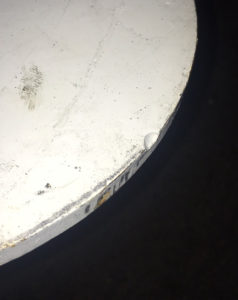
You also want to keep them painted in order to prevent the targets from rusting over. One of the first things I do when ordering steel targets is to put a fresh coat of paint on them. With that said, a little rust isn’t going to destroy the target, it just keeps them looking nice and keeps your hands cleaner when handling.
What Paint Should I Use For Steel Targets?
Just about any kind of paint will do, my favorite is Rustoleum white since it requires less coats than the cheap stuff and the color white contrasts your shots really well. I like to re-paint the surface of my targets after a few rounds of shooting since it is nice to see where you hit your targets.
Conclusion
That just about covers is for now, I hope there was some useful information you took away from this guide. Have fun and shoot safe!
Caligunner Copyright © 2020.
All Rights Reserved. Caligunner.com is a participant in the Amazon Services LLC Associates Program, an affiliate advertising program designed to provide a means for sites to earn advertising fees by advertising and linking to amazon.com.



